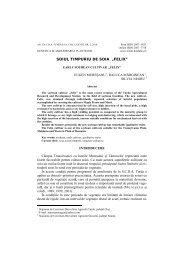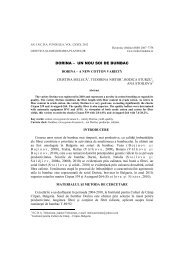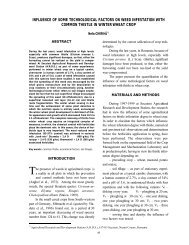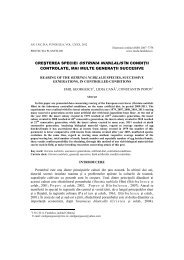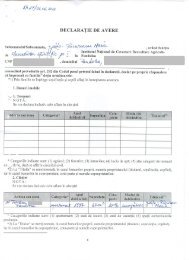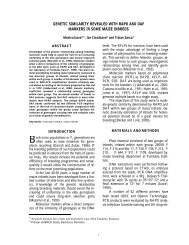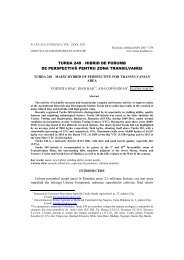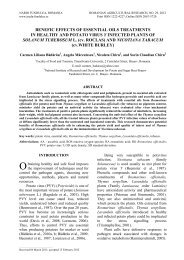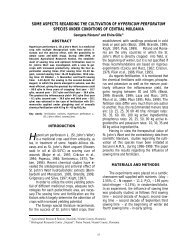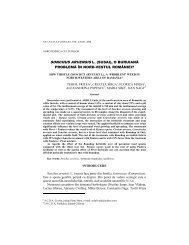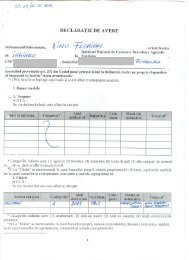the effect of hydric stress on some characteristics of sunflower plants
the effect of hydric stress on some characteristics of sunflower plants
the effect of hydric stress on some characteristics of sunflower plants
Create successful ePaper yourself
Turn your PDF publications into a flip-book with our unique Google optimized e-Paper software.
THE EFFECT OF HYDRIC STRESS ON SOME CHARACTERISTICS<br />
OF SUNFLOWER PLANTS<br />
Elena Petcu, Adrian Arsintescu, Danil Stanciu *)<br />
ABSTRACT<br />
The evoluti<strong>on</strong> <str<strong>on</strong>g>of</str<strong>on</strong>g> leaf area, root volume, chlorophyll c<strong>on</strong>tent<br />
and peroxidase activity for <strong>some</strong> Romanian <strong>sunflower</strong><br />
hybrids, under optimal and drought c<strong>on</strong>diti<strong>on</strong>s<br />
was established. Five Romanian <strong>sunflower</strong> hybrids was<br />
grown in <str<strong>on</strong>g>the</str<strong>on</strong>g> greenhouse under two watering regimes for<br />
each genotype: c<strong>on</strong>trol variant – in which <strong>plants</strong> were<br />
maintained at 70% from TSWC (total soil water capacity)]<br />
and <str<strong>on</strong>g>stress</str<strong>on</strong>g> treatment in which <strong>sunflower</strong> seedlings were<br />
irrigated no more than 40% from TSWC. The results<br />
showed that <str<strong>on</strong>g>hydric</str<strong>on</strong>g> <str<strong>on</strong>g>stress</str<strong>on</strong>g> induced <str<strong>on</strong>g>the</str<strong>on</strong>g> decrease <str<strong>on</strong>g>of</str<strong>on</strong>g> leaf<br />
area, shoot size, root volume, chlorophyll c<strong>on</strong>tent and a<br />
significant increase <str<strong>on</strong>g>of</str<strong>on</strong>g> peroxidase activity. Some differences<br />
between <str<strong>on</strong>g>the</str<strong>on</strong>g> tested <strong>sunflower</strong> hybrids were registered.<br />
Also, a significant <str<strong>on</strong>g>effect</str<strong>on</strong>g> <str<strong>on</strong>g>of</str<strong>on</strong>g> <str<strong>on</strong>g>hydric</str<strong>on</strong>g> <str<strong>on</strong>g>stress</str<strong>on</strong>g> <strong>on</strong> fatty<br />
acid compositi<strong>on</strong> <str<strong>on</strong>g>of</str<strong>on</strong>g> seeds <str<strong>on</strong>g>of</str<strong>on</strong>g> <strong>sunflower</strong> <strong>plants</strong> was registered.<br />
In <str<strong>on</strong>g>the</str<strong>on</strong>g> normal <strong>sunflower</strong> hybrids, like <str<strong>on</strong>g>the</str<strong>on</strong>g> hybrids<br />
<str<strong>on</strong>g>of</str<strong>on</strong>g> this study, in additi<strong>on</strong> to <str<strong>on</strong>g>the</str<strong>on</strong>g> reducti<strong>on</strong> <str<strong>on</strong>g>of</str<strong>on</strong>g> oleic acid<br />
c<strong>on</strong>centrati<strong>on</strong>, a simultaneous increase in <str<strong>on</strong>g>the</str<strong>on</strong>g> c<strong>on</strong>tent <str<strong>on</strong>g>of</str<strong>on</strong>g><br />
linoleic acid under drought c<strong>on</strong>diti<strong>on</strong>s was registered.<br />
Key words: chlorophyll c<strong>on</strong>tent, drought, fatty acid compos i-<br />
ti<strong>on</strong>, leaf area, peroxidase activity, root volume<br />
<strong>sunflower</strong>.<br />
D<br />
INTRODUCTION<br />
rought is probably <str<strong>on</strong>g>the</str<strong>on</strong>g> most important factor<br />
limiting crop yields worldwide and, in<br />
Romania, too. Because <str<strong>on</strong>g>of</str<strong>on</strong>g> its complexity,<br />
drought tolerance is probably <str<strong>on</strong>g>the</str<strong>on</strong>g> most difficult<br />
trait to improve through c<strong>on</strong>venti<strong>on</strong>al plant<br />
breeding. The challenge is even greater for developing<br />
drought tolerant cultivars for Romanian<br />
envir<strong>on</strong>ment where <str<strong>on</strong>g>the</str<strong>on</strong>g> occurrence, timing<br />
and severity <str<strong>on</strong>g>of</str<strong>on</strong>g> drought may fluctuate from year<br />
to year.<br />
R.I.C.I.C. Fundulea has devoted c<strong>on</strong>siderable<br />
effort during <str<strong>on</strong>g>the</str<strong>on</strong>g> past ten years to improve<br />
drought tolerance in wheat, maize and <strong>sunflower</strong>.<br />
Extensive research has been c<strong>on</strong>ducted<br />
in <str<strong>on</strong>g>the</str<strong>on</strong>g> area <str<strong>on</strong>g>of</str<strong>on</strong>g> breeding, agr<strong>on</strong>omy, and most<br />
recently, physiology.<br />
The physiology work has focused <strong>on</strong> morpho-physiologycal<br />
traits induced by drought<br />
and associated with drought tolerance <str<strong>on</strong>g>of</str<strong>on</strong>g> <strong>plants</strong><br />
(I), and <str<strong>on</strong>g>the</str<strong>on</strong>g> elaborati<strong>on</strong> <str<strong>on</strong>g>of</str<strong>on</strong>g> screening methods<br />
for rapidly measuring <str<strong>on</strong>g>of</str<strong>on</strong>g> drought to-lerance using<br />
<strong>plants</strong> in earlier stage <str<strong>on</strong>g>of</str<strong>on</strong>g> vegetati<strong>on</strong> (II).<br />
Sunflower is a well adapted to drought<br />
crop, essentially because <str<strong>on</strong>g>of</str<strong>on</strong>g> <str<strong>on</strong>g>the</str<strong>on</strong>g> powerful water<br />
uptake due to its efficient root system (Belhassen,<br />
1995).<br />
The present paper reports <str<strong>on</strong>g>the</str<strong>on</strong>g> reacti<strong>on</strong>s <str<strong>on</strong>g>of</str<strong>on</strong>g><br />
five Romanian <strong>sunflower</strong> genotypes to <str<strong>on</strong>g>hydric</str<strong>on</strong>g><br />
<str<strong>on</strong>g>stress</str<strong>on</strong>g>. The aim was to identify morphophysiologycal<br />
traits that could be used as<br />
screening criteria in a breeding programme for<br />
drought tolerance and which could be rapidly<br />
measured using <strong>plants</strong> in an earlier stage <str<strong>on</strong>g>of</str<strong>on</strong>g><br />
vegetati<strong>on</strong>.<br />
MATERIALS AND METHODS<br />
Experiment 1<br />
Seeds <str<strong>on</strong>g>of</str<strong>on</strong>g> five <strong>sunflower</strong> hybrids: Alex, Favorit,<br />
Justin, Romina and Splendor were germinated<br />
and <str<strong>on</strong>g>the</str<strong>on</strong>g>n planted at a depth <str<strong>on</strong>g>of</str<strong>on</strong>g> 3–4 cm in<br />
PVC tubes (35 cm l<strong>on</strong>g and 11 cm diameter)<br />
filled with a soil-sand mixture (1:1).<br />
Each genotype was tested in five replicates,<br />
at four leaves stage and two watering regimes<br />
for each genotype: c<strong>on</strong>trol variant – [in<br />
which <strong>plants</strong> were maintained at 70% from<br />
TSWC (total soil water capacity)] and <str<strong>on</strong>g>stress</str<strong>on</strong>g><br />
treatment (where <strong>sunflower</strong> seedlings were irrigated<br />
no more than 40% from TSWC).<br />
The biomass <str<strong>on</strong>g>of</str<strong>on</strong>g> <str<strong>on</strong>g>the</str<strong>on</strong>g> above and belowground<br />
parts was measured after drying <str<strong>on</strong>g>the</str<strong>on</strong>g>m to<br />
<str<strong>on</strong>g>the</str<strong>on</strong>g> c<strong>on</strong>stant weight.<br />
The chlorophyll c<strong>on</strong>centrati<strong>on</strong> was assessed<br />
using a SPAD-502 chlorophyll meter<br />
(Minolta, Japan).<br />
Leaf area was calculated with <str<strong>on</strong>g>the</str<strong>on</strong>g> formula:<br />
L x l x 0.66 where: L = leaf length; l = leaf<br />
width and 0.66 = correcti<strong>on</strong> coefficient for <strong>sunflower</strong>.<br />
The root volume was measured by water<br />
displacement from a filled beaker.<br />
*) Research Institute for Cereals and Industrial Crops, 8264 Fundulea, Calarasi County, Romania<br />
15
16<br />
ROMANIAN AGRICULTURAL RESEARCH<br />
Number 16 / 2001<br />
For peroxidase determinati<strong>on</strong> <str<strong>on</strong>g>the</str<strong>on</strong>g> vertical<br />
electrophoresis in polyacrilamide native gel was<br />
used.<br />
Experiment 2<br />
Five standard <strong>sunflower</strong> hybrids provided<br />
by Fundulea Research Institute were used in<br />
this experiment: Alex, Favorit, Justin, Romina<br />
and Splendor.<br />
The seeds were sown in pots (27 kg capacity)<br />
in soil: sand (4:1) mixture, in vegetati<strong>on</strong><br />
house.<br />
The experimental variants were:<br />
a) c<strong>on</strong>trol – <str<strong>on</strong>g>the</str<strong>on</strong>g> <strong>sunflower</strong> <strong>plants</strong> were kept<br />
up to physiological maturity at optimal soil humidity<br />
c<strong>on</strong>diti<strong>on</strong>s, 70% soil water capacity respectively;<br />
b) drought – was induced before flowering<br />
and 12 days after flowering <str<strong>on</strong>g>the</str<strong>on</strong>g> <strong>sunflower</strong><br />
<strong>plants</strong> were kept at 40% soil water capacity;<br />
The fatty acids were analysed by gas<br />
chromatography (GS) according to <str<strong>on</strong>g>the</str<strong>on</strong>g> c<strong>on</strong>venti<strong>on</strong>al<br />
method: <str<strong>on</strong>g>the</str<strong>on</strong>g> transformati<strong>on</strong> <str<strong>on</strong>g>of</str<strong>on</strong>g> triglycerides<br />
to fatty acid methyl esters was performed<br />
with trimethylsulf<strong>on</strong>iumhydroxid (TMSH). The<br />
capillary column (BP x 70) by 25 m length <strong>on</strong><br />
a DELSI gas chromatograph with flame i<strong>on</strong>izati<strong>on</strong><br />
detector (FID) was used. Injector and detector<br />
temperature were kept at 270 and 280 ° C.<br />
The carrier gas was helium, with a flow rate <str<strong>on</strong>g>of</str<strong>on</strong>g><br />
20 ml/min. The total area <str<strong>on</strong>g>of</str<strong>on</strong>g> <str<strong>on</strong>g>the</str<strong>on</strong>g> peaks and <str<strong>on</strong>g>the</str<strong>on</strong>g><br />
area <str<strong>on</strong>g>of</str<strong>on</strong>g> each fatty acid peak was expressed as a<br />
percentage <str<strong>on</strong>g>of</str<strong>on</strong>g> <str<strong>on</strong>g>the</str<strong>on</strong>g> total area.<br />
RESULTS AND DISCUSSION<br />
As first resp<strong>on</strong>se <str<strong>on</strong>g>of</str<strong>on</strong>g> <strong>sunflower</strong> seedlings<br />
grown under <str<strong>on</strong>g>hydric</str<strong>on</strong>g> <str<strong>on</strong>g>stress</str<strong>on</strong>g> c<strong>on</strong>diti<strong>on</strong>s <str<strong>on</strong>g>the</str<strong>on</strong>g> reducti<strong>on</strong><br />
<str<strong>on</strong>g>of</str<strong>on</strong>g> leaf area and height <str<strong>on</strong>g>of</str<strong>on</strong>g> <strong>plants</strong> were registered.<br />
Leaf area was insignificantly reduced in<br />
<strong>sunflower</strong> grown <strong>on</strong>e week under drought c<strong>on</strong>diti<strong>on</strong>s<br />
(from 0.8% for Favorit up to 15% for<br />
Justin hybrid) and significantly reduced in all<br />
<strong>sunflower</strong> genotypes grown two weeks under<br />
drought c<strong>on</strong>diti<strong>on</strong>s (up to 50%) (Table 1).<br />
In all <strong>sunflower</strong> hybrids, <str<strong>on</strong>g>the</str<strong>on</strong>g> <str<strong>on</strong>g>effect</str<strong>on</strong>g> <str<strong>on</strong>g>of</str<strong>on</strong>g><br />
drought treatment c<strong>on</strong>sisted in a significant decrease<br />
<str<strong>on</strong>g>of</str<strong>on</strong>g> height <str<strong>on</strong>g>of</str<strong>on</strong>g> <strong>plants</strong>, less in hybrid Alex<br />
and more in hybrid Justin (Table 2).<br />
Table 1. The <str<strong>on</strong>g>effect</str<strong>on</strong>g> <str<strong>on</strong>g>of</str<strong>on</strong>g> <str<strong>on</strong>g>hydric</str<strong>on</strong>g> <str<strong>on</strong>g>stress</str<strong>on</strong>g> <strong>on</strong> leaf area <str<strong>on</strong>g>of</str<strong>on</strong>g><br />
<strong>sunflower</strong> seedlings<br />
Leaf area<br />
Hybrids<br />
(1 week) (2 weeks)<br />
Hydric <str<strong>on</strong>g>stress</str<strong>on</strong>g> Hydric <str<strong>on</strong>g>stress</str<strong>on</strong>g><br />
Variants<br />
mm 2 % mm 2 %<br />
Alex<br />
C<strong>on</strong>trol 4.77 100 55.52 100<br />
Drought 4.36 91.5 24.85 44.8<br />
Favorit<br />
C<strong>on</strong>trol 6.23 100 62.95 100<br />
Drought 6.18 99.2 29.83 47.4<br />
Justin<br />
C<strong>on</strong>trol 5.23 100 49.42 100<br />
Drought 4.44 85.0 28.46 57.6<br />
Romin C<strong>on</strong>trol 5.55 100 54.92 100<br />
a Drought 5.32 99.6 28.68 52.2<br />
Splendor<br />
C<strong>on</strong>trol 5.15 100 56.77 100<br />
Drought 4.93 95.7 28.38<br />
50.0<br />
Table 2 . The <str<strong>on</strong>g>effect</str<strong>on</strong>g> <str<strong>on</strong>g>of</str<strong>on</strong>g> <str<strong>on</strong>g>hydric</str<strong>on</strong>g> <str<strong>on</strong>g>stress</str<strong>on</strong>g> <strong>on</strong> shoot size <str<strong>on</strong>g>of</str<strong>on</strong>g><br />
<strong>sunflower</strong> seedlings<br />
Hybrids<br />
Alex<br />
Favorit<br />
Justin<br />
Romina<br />
Splendor<br />
Height <str<strong>on</strong>g>of</str<strong>on</strong>g><br />
Variants<br />
<strong>plants</strong><br />
mm %<br />
C<strong>on</strong>trol 621 100<br />
Hydric <str<strong>on</strong>g>stress</str<strong>on</strong>g> (2 weeks) 457 73.6<br />
C<strong>on</strong>trol 641 100<br />
Hydric <str<strong>on</strong>g>stress</str<strong>on</strong>g> (2 weeks) 459 71.6<br />
C<strong>on</strong>trol 600 100<br />
Hydric <str<strong>on</strong>g>stress</str<strong>on</strong>g> (2 weeks) 385 64.2<br />
C<strong>on</strong>trol 659 100<br />
Hydric <str<strong>on</strong>g>stress</str<strong>on</strong>g> (2 weeks) 450 68.3<br />
C<strong>on</strong>trol 571 100<br />
Hydric <str<strong>on</strong>g>stress</str<strong>on</strong>g> (2 weeks) 413 72.3<br />
The significant positive correlati<strong>on</strong> between<br />
leaf area and plant height under <str<strong>on</strong>g>hydric</str<strong>on</strong>g><br />
<str<strong>on</strong>g>stress</str<strong>on</strong>g> c<strong>on</strong>diti<strong>on</strong> is obvious (r = 0.953***, Figure<br />
1).<br />
Figure 1. The correlati<strong>on</strong> between leaf area and height<br />
<str<strong>on</strong>g>of</str<strong>on</strong>g> <strong>sunflower</strong> seedlings under <str<strong>on</strong>g>hydric</str<strong>on</strong>g> <str<strong>on</strong>g>stress</str<strong>on</strong>g>
ELENA PETCU ET AL.: THE EFFECT OF HYDRIC STRESS ON SOME CHARACTERISTICS<br />
OF SUNFLOWER PLANTS<br />
17<br />
During <str<strong>on</strong>g>the</str<strong>on</strong>g> different stages <str<strong>on</strong>g>of</str<strong>on</strong>g> vegetati<strong>on</strong><br />
<str<strong>on</strong>g>the</str<strong>on</strong>g> hybrid Favorit has registered a higher value<br />
<str<strong>on</strong>g>of</str<strong>on</strong>g> leaf area both under c<strong>on</strong>trol and <str<strong>on</strong>g>hydric</str<strong>on</strong>g> <str<strong>on</strong>g>stress</str<strong>on</strong>g><br />
variants as compared with <str<strong>on</strong>g>the</str<strong>on</strong>g> hybrid Justin<br />
(Figure 2). This resp<strong>on</strong>se could be c<strong>on</strong>sidered<br />
as an usual reacti<strong>on</strong> <str<strong>on</strong>g>of</str<strong>on</strong>g> <strong>sunflower</strong> <strong>plants</strong> in order<br />
to reduce water use.<br />
Figure 2. The <str<strong>on</strong>g>effect</str<strong>on</strong>g> <str<strong>on</strong>g>of</str<strong>on</strong>g> <str<strong>on</strong>g>hydric</str<strong>on</strong>g> <str<strong>on</strong>g>stress</str<strong>on</strong>g> <strong>on</strong> leaf area <str<strong>on</strong>g>of</str<strong>on</strong>g> <strong>sunflower</strong><br />
<strong>plants</strong> at different data <str<strong>on</strong>g>of</str<strong>on</strong>g> analyses<br />
(1 = before flowering; 2 = at 1 week after<br />
flowering; 3 = at 2 weeks a fter flowering)<br />
The chlorophyll c<strong>on</strong>tent is <strong>on</strong>e <str<strong>on</strong>g>of</str<strong>on</strong>g> <str<strong>on</strong>g>the</str<strong>on</strong>g> most important<br />
indicators <str<strong>on</strong>g>of</str<strong>on</strong>g> vegetati<strong>on</strong> stage and its<br />
degradati<strong>on</strong> is normally c<strong>on</strong>sidered a measure<br />
<str<strong>on</strong>g>of</str<strong>on</strong>g> drought resistance (Beard, 1973; Kim et al.,<br />
1989). The total chlorophyll c<strong>on</strong>tent (expressed<br />
as SPAD units) was reduced under drought<br />
c<strong>on</strong>diti<strong>on</strong>s, except for Favorit and Justin which<br />
presented after two weeks under <str<strong>on</strong>g>hydric</str<strong>on</strong>g> <str<strong>on</strong>g>stress</str<strong>on</strong>g><br />
c<strong>on</strong>diti<strong>on</strong>s an insignificant increase <str<strong>on</strong>g>of</str<strong>on</strong>g> chlorophyll<br />
c<strong>on</strong>tent as compared with c<strong>on</strong>trol (Figure<br />
3).<br />
Chlorophyll c<strong>on</strong>tent (SPAD units)<br />
60<br />
50<br />
40<br />
30<br />
20<br />
10<br />
0<br />
Alex Favorit Justin Romina<br />
C<strong>on</strong>trol 1 Hydric <str<strong>on</strong>g>stress</str<strong>on</strong>g> 1 C<strong>on</strong>trol 2 Hydric <str<strong>on</strong>g>stress</str<strong>on</strong>g> 2<br />
Figure 3. Effect <str<strong>on</strong>g>of</str<strong>on</strong>g> hydri c <str<strong>on</strong>g>stress</str<strong>on</strong>g> <strong>on</strong> chlorophyll c<strong>on</strong>tent<br />
in <strong>sunflower</strong> leaves<br />
Dry matter producti<strong>on</strong> <str<strong>on</strong>g>of</str<strong>on</strong>g> shoots, leaves<br />
and roots was significantly reduced under <str<strong>on</strong>g>hydric</str<strong>on</strong>g><br />
<str<strong>on</strong>g>stress</str<strong>on</strong>g> c<strong>on</strong>diti<strong>on</strong>s for all tested genotypes.<br />
Beside <str<strong>on</strong>g>the</str<strong>on</strong>g> genetic variability <str<strong>on</strong>g>of</str<strong>on</strong>g> tested <strong>sunflower</strong><br />
hybrids, differences were registered between<br />
<str<strong>on</strong>g>the</str<strong>on</strong>g> analysed organs, too. It is obvious<br />
that leaves and shoots were more influenced by<br />
<str<strong>on</strong>g>hydric</str<strong>on</strong>g> <str<strong>on</strong>g>stress</str<strong>on</strong>g> than roots.<br />
Thus, dry matter accumulati<strong>on</strong> in roots <str<strong>on</strong>g>of</str<strong>on</strong>g><br />
Favorit hybrid under drought is higher than under<br />
c<strong>on</strong>trol. Also, <str<strong>on</strong>g>the</str<strong>on</strong>g> values <str<strong>on</strong>g>of</str<strong>on</strong>g> <str<strong>on</strong>g>the</str<strong>on</strong>g> rest <str<strong>on</strong>g>of</str<strong>on</strong>g> <str<strong>on</strong>g>the</str<strong>on</strong>g><br />
tested <strong>sunflower</strong> hybrids were up to 70%. Under<br />
<str<strong>on</strong>g>hydric</str<strong>on</strong>g> <str<strong>on</strong>g>stress</str<strong>on</strong>g> c<strong>on</strong>diti<strong>on</strong>s, <str<strong>on</strong>g>the</str<strong>on</strong>g> root/shoot ratio<br />
increases. The increase in <str<strong>on</strong>g>the</str<strong>on</strong>g> Favorit hybrid<br />
was obvious (72%) and from 23 to 45,8% in<br />
Romina and respectively Justin. These results<br />
show that <str<strong>on</strong>g>the</str<strong>on</strong>g> total root mass increases with<br />
drought <str<strong>on</strong>g>stress</str<strong>on</strong>g> (Table 3).<br />
The shoot/root mass ratios c<strong>on</strong>sistently decrease<br />
under drought <str<strong>on</strong>g>stress</str<strong>on</strong>g>, which is a universal<br />
expressi<strong>on</strong> <str<strong>on</strong>g>of</str<strong>on</strong>g> adaptati<strong>on</strong> (Blum, 1988). The<br />
increase <str<strong>on</strong>g>of</str<strong>on</strong>g> root/shoot ratio is menti<strong>on</strong>ed in literature<br />
(Sharp and Davies, 1985; Sharp and<br />
Boyer, 1986). Previous reports underlined <str<strong>on</strong>g>the</str<strong>on</strong>g><br />
genetic diversity <str<strong>on</strong>g>of</str<strong>on</strong>g> hybrid <strong>sunflower</strong> roots and<br />
<str<strong>on</strong>g>the</str<strong>on</strong>g> influence <str<strong>on</strong>g>of</str<strong>on</strong>g> soil envir<strong>on</strong>mental c<strong>on</strong>diti<strong>on</strong>s<br />
<strong>on</strong> <str<strong>on</strong>g>the</str<strong>on</strong>g> rooting system (Þerbea et al., 1995;<br />
Petcu et al., 1997; Aguera et al., 1997).<br />
Our results show that during <str<strong>on</strong>g>the</str<strong>on</strong>g> first days<br />
<str<strong>on</strong>g>of</str<strong>on</strong>g> <str<strong>on</strong>g>hydric</str<strong>on</strong>g> <str<strong>on</strong>g>stress</str<strong>on</strong>g> <str<strong>on</strong>g>the</str<strong>on</strong>g> nutritive reserves <str<strong>on</strong>g>of</str<strong>on</strong>g> <strong>sunflower</strong><br />
seedlings were c<strong>on</strong>ducted to develop <str<strong>on</strong>g>the</str<strong>on</strong>g><br />
roots, in order to facilitate deep soil moisture<br />
extracti<strong>on</strong>. This happens in detriment <str<strong>on</strong>g>of</str<strong>on</strong>g> shoot<br />
development and in this case a drift is occurring<br />
in <str<strong>on</strong>g>the</str<strong>on</strong>g> main sink for surviving. C<strong>on</strong>cerning <str<strong>on</strong>g>the</str<strong>on</strong>g><br />
root/shoot ratio, <str<strong>on</strong>g>the</str<strong>on</strong>g> resp<strong>on</strong>se <str<strong>on</strong>g>of</str<strong>on</strong>g> mature <strong>plants</strong> to<br />
<str<strong>on</strong>g>hydric</str<strong>on</strong>g> <str<strong>on</strong>g>stress</str<strong>on</strong>g> is different than seedling resp<strong>on</strong>se<br />
as <str<strong>on</strong>g>the</str<strong>on</strong>g> sink is different.<br />
The root/shoot ratio <str<strong>on</strong>g>of</str<strong>on</strong>g> mature <strong>plants</strong> decreases<br />
under drought <str<strong>on</strong>g>stress</str<strong>on</strong>g> in Favorit and<br />
Splendor but increases in Alex, Justin and<br />
Romina hybrid. So, <strong>some</strong> differences between<br />
<str<strong>on</strong>g>the</str<strong>on</strong>g> tested genotypes in resp<strong>on</strong>se <str<strong>on</strong>g>of</str<strong>on</strong>g> drought<br />
were noticed (Table 4).<br />
The head/shoot ratio increased under<br />
drought in all genotypes, this proving <str<strong>on</strong>g>the</str<strong>on</strong>g> different<br />
sinks at mature <strong>plants</strong> (Figure 4).<br />
It is well known that water <str<strong>on</strong>g>stress</str<strong>on</strong>g> has a pr<str<strong>on</strong>g>of</str<strong>on</strong>g>ound<br />
<str<strong>on</strong>g>effect</str<strong>on</strong>g> <strong>on</strong> <strong>sunflower</strong> yield (Murriel and
18<br />
ROMANIAN AGRICULTURAL RESEARCH<br />
Number 16 / 2001<br />
Downes, 1974; Talha and Osman, 1975) productive hybrids under drought c<strong>on</strong>diti<strong>on</strong>s<br />
and<br />
were Favorit and Justin.<br />
Table 3. The <str<strong>on</strong>g>effect</str<strong>on</strong>g> <str<strong>on</strong>g>of</str<strong>on</strong>g> <str<strong>on</strong>g>hydric</str<strong>on</strong>g> <str<strong>on</strong>g>stress</str<strong>on</strong>g> <strong>on</strong> biomass accumulati<strong>on</strong> in seedling <strong>sunflower</strong> hybrids<br />
Biomass accumulati<strong>on</strong> (g dry matter)<br />
Hybrids Experimental variants Leaves Shoots Roots<br />
Roots/shoot<br />
g % g % g % ratio %<br />
Alex<br />
C<strong>on</strong>trol 2.87 100 4.37 100 2.35 100 0.32 100<br />
Hydric <str<strong>on</strong>g>stress</str<strong>on</strong>g> (2 weeks) 1.48 51.5 1.93 44.1 1.42 60.42 0.42 131.2<br />
Favorit<br />
C<strong>on</strong>trol 3.24 100 4.60 100 1.52 100 0.19 100<br />
Hydric <str<strong>on</strong>g>stress</str<strong>on</strong>g> (2 weeks) 1.86 57.4 2.87 62.2 1.58 103.9 0.33 173.6<br />
Justin<br />
C<strong>on</strong>trol 2.72 100 4.97 100 1.86 100 0.24 100<br />
Hydric <str<strong>on</strong>g>stress</str<strong>on</strong>g> (2 weeks) 1.70 62.5 2.91 58.5 1.60 86.02 0.35 145.8<br />
Romina<br />
C<strong>on</strong>trol 3.22 100 5.29 100 1.83 100 0.22 100<br />
Hydric <str<strong>on</strong>g>stress</str<strong>on</strong>g> (2 weeks) 2.22 68.9 2.5 47.2 1.29 70.49 0.27 123<br />
Splendor<br />
C<strong>on</strong>trol 3.12 100 4.88 100 1.87 100 0.23 100<br />
Hydric <str<strong>on</strong>g>stress</str<strong>on</strong>g> (2 weeks) 1.81 58.0 3.51 71.9 1.60 85.56 0.30 130.4<br />
Table 4. The <str<strong>on</strong>g>effect</str<strong>on</strong>g> <str<strong>on</strong>g>of</str<strong>on</strong>g> <str<strong>on</strong>g>hydric</str<strong>on</strong>g> <str<strong>on</strong>g>stress</str<strong>on</strong>g> <strong>on</strong> biomass accumulati<strong>on</strong> in mature <strong>sunflower</strong> <strong>plants</strong><br />
Biomass accumulati<strong>on</strong> (g dry matter)<br />
Hybrids Experimental variants Shoots Leaves Roots<br />
Roots/shoot<br />
g % g % g % ratio %<br />
Alex C<strong>on</strong>trol 36.8 100 20.4 100 10.8 100 0.19 100<br />
Hydric <str<strong>on</strong>g>stress</str<strong>on</strong>g> (2 weeks) 21.6 58.70 18.6 91.18 9.4 87.04 0.23 123.8<br />
Favorit C<strong>on</strong>trol 36.8 100 38 100 21.2 100 0.28 100<br />
Hydric <str<strong>on</strong>g>stress</str<strong>on</strong>g> (2 weeks) 35.6 96.74 21.4 56.32 6.4 30.19 0.11 39.6<br />
Justin C<strong>on</strong>trol 34.4 100 29.2 100 9.4 100 0.15 100<br />
Hydric <str<strong>on</strong>g>stress</str<strong>on</strong>g> (2 weeks) 17.4 50.58 18 61.64 6.6 70.21 0.19 126.1<br />
Romina<br />
C<strong>on</strong>trol 28.8 100 18.8 100 7.6 100 0.16 100<br />
Hydric <str<strong>on</strong>g>stress</str<strong>on</strong>g> (2 weeks) 15.6 54.17 18.2 96.81 7.2 94.74 0.21 133.4<br />
Splendor C<strong>on</strong>trol 29.4 100 31.2 100 22.4 100 0.37 100<br />
Hydric <str<strong>on</strong>g>stress</str<strong>on</strong>g> (2 weeks) 21.4 72.79 23.4 75.00 10.4 46.43 0.23 62.8<br />
.<br />
60<br />
50<br />
C<strong>on</strong>trol<br />
Drought<br />
Yield (g/<strong>plants</strong>)<br />
40<br />
30<br />
20<br />
10<br />
0<br />
Alex Favorit Justin Romina<br />
Figure 4. The <str<strong>on</strong>g>effect</str<strong>on</strong>g> <str<strong>on</strong>g>of</str<strong>on</strong>g> <str<strong>on</strong>g>hydric</str<strong>on</strong>g> <str<strong>on</strong>g>stress</str<strong>on</strong>g> <strong>on</strong> head weight/<br />
shoot weight ratio <str<strong>on</strong>g>of</str<strong>on</strong>g> <str<strong>on</strong>g>the</str<strong>on</strong>g> tested <strong>sunflower</strong><br />
hybrids<br />
seeds compositi<strong>on</strong> in fatty acids is also affected<br />
by water <str<strong>on</strong>g>stress</str<strong>on</strong>g> (Baldini et al., 2000).<br />
Grain yield was affected by <str<strong>on</strong>g>hydric</str<strong>on</strong>g> <str<strong>on</strong>g>stress</str<strong>on</strong>g><br />
with <str<strong>on</strong>g>the</str<strong>on</strong>g> low status treatment yielding 10-13%<br />
less than <str<strong>on</strong>g>the</str<strong>on</strong>g> c<strong>on</strong>trol (Figure 5). The highest<br />
Figure 5. The <str<strong>on</strong>g>effect</str<strong>on</strong>g> <str<strong>on</strong>g>of</str<strong>on</strong>g> <str<strong>on</strong>g>hydric</str<strong>on</strong>g> <str<strong>on</strong>g>stress</str<strong>on</strong>g> <strong>on</strong> yield <str<strong>on</strong>g>of</str<strong>on</strong>g> <str<strong>on</strong>g>the</str<strong>on</strong>g><br />
tested <strong>sunflower</strong> hybrids<br />
This suggests that although in Justin hybrid<br />
most part <str<strong>on</strong>g>of</str<strong>on</strong>g> <str<strong>on</strong>g>the</str<strong>on</strong>g> nutritive reserve is c<strong>on</strong>ducted to<br />
root development, <str<strong>on</strong>g>the</str<strong>on</strong>g> yield is not influenced.<br />
The thousand seed weight (TKW) <str<strong>on</strong>g>of</str<strong>on</strong>g><br />
Justin decreases under drought c<strong>on</strong>diti<strong>on</strong>s as<br />
compared with Favorit. The TKW <str<strong>on</strong>g>of</str<strong>on</strong>g> Alex hy-
ELENA PETCU ET AL.: THE EFFECT OF HYDRIC STRESS ON SOME CHARACTERISTICS<br />
OF SUNFLOWER PLANTS<br />
19<br />
brid is diminished under drought c<strong>on</strong>diti<strong>on</strong>s, too<br />
(Figure 6).<br />
Performer 7,45 12,50<br />
The adverse envir<strong>on</strong>mental growth c<strong>on</strong>diti<strong>on</strong>s<br />
are reported to induce a degrading process<br />
in <strong>plants</strong> as a c<strong>on</strong>sequence <str<strong>on</strong>g>of</str<strong>on</strong>g> a generating partially<br />
reduced oxygen (activated oxygen). It is<br />
now well documented that drought c<strong>on</strong>diti<strong>on</strong>s,<br />
pathogen attack or atmospheric polluti<strong>on</strong> lead to<br />
perturbati<strong>on</strong> <str<strong>on</strong>g>of</str<strong>on</strong>g> <str<strong>on</strong>g>the</str<strong>on</strong>g> redox state towards an oxidative<br />
metabolism within plant cell (Vanacker<br />
et al., 1988; Ranieri et al., 1999).<br />
Figure 6. The <str<strong>on</strong>g>effect</str<strong>on</strong>g> <str<strong>on</strong>g>of</str<strong>on</strong>g> <str<strong>on</strong>g>hydric</str<strong>on</strong>g> <str<strong>on</strong>g>stress</str<strong>on</strong>g> <strong>on</strong> TSW <str<strong>on</strong>g>of</str<strong>on</strong>g> <strong>sunflower</strong><br />
hybrids<br />
A significant correlati<strong>on</strong> has been found<br />
between diameter <str<strong>on</strong>g>of</str<strong>on</strong>g> head and root/shoot ratio<br />
(Figure 7).<br />
1 2 3 4 5 6<br />
Drought<br />
C<strong>on</strong>trol<br />
Figure 8. Isoenzyme <str<strong>on</strong>g>of</str<strong>on</strong>g> peroxidase for three su nflower<br />
hybrids: Favorit (1), Justin (2), Select (3)<br />
Figure 7. The relati<strong>on</strong>ships between diameter <str<strong>on</strong>g>of</str<strong>on</strong>g> head<br />
and root/shoot ratio <str<strong>on</strong>g>of</str<strong>on</strong>g> <strong>sunflower</strong> seedlings<br />
The peroxidase activity increases in <strong>sunflower</strong><br />
<strong>plants</strong> under <str<strong>on</strong>g>hydric</str<strong>on</strong>g> <str<strong>on</strong>g>stress</str<strong>on</strong>g> (for peroxidase<br />
determinati<strong>on</strong> <str<strong>on</strong>g>the</str<strong>on</strong>g> supplementary <str<strong>on</strong>g>hydric</str<strong>on</strong>g><br />
<str<strong>on</strong>g>stress</str<strong>on</strong>g> was induced with 15% PEG for six<br />
hours) (Table 5) and <strong>some</strong> modificati<strong>on</strong>s in<br />
isoenzime pattern were registered (Figure 8).<br />
Table 5. Peroxidase activity (U guaiacol<br />
oxidized/min/mg proteins/g dry matter)<br />
Genotypes C<strong>on</strong>trol Drought<br />
Alex 10,50 14,15<br />
Favorit 12,50 16,85<br />
Justin 9,50 12,25<br />
Select 6,35 14,35<br />
Under <str<strong>on</strong>g>stress</str<strong>on</strong>g> c<strong>on</strong>diti<strong>on</strong>s <str<strong>on</strong>g>the</str<strong>on</strong>g> enhanced <str<strong>on</strong>g>of</str<strong>on</strong>g><br />
peroxidase activity stimulated cell wall stiffening,<br />
probably reducing cell growth which might<br />
represent a mechanical adaptati<strong>on</strong> to adverse<br />
c<strong>on</strong>diti<strong>on</strong>s (Castillo et al., 1984, 1987).<br />
The saturated fatty acid c<strong>on</strong>tents (palmitic<br />
and stearic acids) were insignificantly affected<br />
by water <str<strong>on</strong>g>stress</str<strong>on</strong>g>. The palmitic acid c<strong>on</strong>centrati<strong>on</strong><br />
increases under two weeks <str<strong>on</strong>g>hydric</str<strong>on</strong>g> <str<strong>on</strong>g>stress</str<strong>on</strong>g> c<strong>on</strong>diti<strong>on</strong>s<br />
(from 6% for Favorit to 12% for Alex hybrid)<br />
and stearic acid c<strong>on</strong>centrati<strong>on</strong> decreased<br />
under <str<strong>on</strong>g>the</str<strong>on</strong>g> same c<strong>on</strong>diti<strong>on</strong>s (from 2 % for<br />
Alex to 29% for Favorit hybrid respectively)<br />
(Table 6).<br />
There was a significant negative <str<strong>on</strong>g>effect</str<strong>on</strong>g> <str<strong>on</strong>g>of</str<strong>on</strong>g><br />
drought <strong>on</strong> <str<strong>on</strong>g>the</str<strong>on</strong>g> oleic acid c<strong>on</strong>centrati<strong>on</strong> in all<br />
tested <strong>sunflower</strong> hybrids. The decrease was<br />
more obvious after two weeks <str<strong>on</strong>g>of</str<strong>on</strong>g> <str<strong>on</strong>g>hydric</str<strong>on</strong>g> <str<strong>on</strong>g>stress</str<strong>on</strong>g>
20<br />
ROMANIAN AGRICULTURAL RESEARCH<br />
Number 16 / 2001<br />
for Alex and Justin (37 and 30% respectively)<br />
than for Favorit hybrid (13%) (Tables 6 and 7).<br />
reducti<strong>on</strong> <str<strong>on</strong>g>of</str<strong>on</strong>g> about 15% in <str<strong>on</strong>g>the</str<strong>on</strong>g> c<strong>on</strong>centrati<strong>on</strong> <str<strong>on</strong>g>of</str<strong>on</strong>g><br />
oleic acid in standard hybrids.<br />
Fatty<br />
acids<br />
Table 6. The <str<strong>on</strong>g>effect</str<strong>on</strong>g> <str<strong>on</strong>g>of</str<strong>on</strong>g> <str<strong>on</strong>g>hydric</str<strong>on</strong>g> <str<strong>on</strong>g>stress</str<strong>on</strong>g> (1 week) <strong>on</strong> fatty acid compositi<strong>on</strong> in several Romanian <strong>sunflower</strong> hybrids<br />
Experimental<br />
variants<br />
%<br />
from<br />
total<br />
area<br />
Alex Favorit Justin Romina Splendor<br />
differences<br />
%<br />
differences<br />
%<br />
diffe - % from differences<br />
%<br />
from<br />
from<br />
rences total<br />
from<br />
%<br />
total<br />
%<br />
total<br />
% area %<br />
total<br />
area<br />
area<br />
area<br />
differences<br />
%<br />
Palmitic C<strong>on</strong>trol 6.58 100 5.82 100 6.38 100 7.14 100 6.09 100<br />
acid Hydric <str<strong>on</strong>g>stress</str<strong>on</strong>g> 6.72 102 6.3 108 6.28 98 6.94 97 6.09 100<br />
Stearic C<strong>on</strong>trol 6.57 100 4.32 100 3.6 100 4.41 100 6.41 100<br />
acid Hydric <str<strong>on</strong>g>stress</str<strong>on</strong>g> 5.63 86 3.89 90 4.05 113 5.37 122 5.02 78<br />
Oleic C<strong>on</strong>trol 36.91 100 52.09 100 44.92 100 29.78 100 52.03 100<br />
acid Hydric <str<strong>on</strong>g>stress</str<strong>on</strong>g> 33.28 90 35.27 68 35.54 79 29.32 98 38.59 74<br />
Linoleic C<strong>on</strong>trol 46.45 100 34.89 100 43.44 100 56.1 100 32.89 100<br />
acid Hydric <str<strong>on</strong>g>stress</str<strong>on</strong>g> 51.57 111 52.11 149 50.92 117 55.7 99 47.38 144<br />
Table 7. The <str<strong>on</strong>g>effect</str<strong>on</strong>g> <str<strong>on</strong>g>of</str<strong>on</strong>g> <str<strong>on</strong>g>hydric</str<strong>on</strong>g> <str<strong>on</strong>g>stress</str<strong>on</strong>g> (2 weeks) <strong>on</strong> fatty acid compositi<strong>on</strong> in several Romanian <strong>sunflower</strong> hybrids<br />
Fatty<br />
acids<br />
Experimental<br />
variants<br />
%<br />
from<br />
total<br />
area<br />
Alex Favorit Justin Romina Splendor<br />
%<br />
%<br />
%<br />
differences<br />
ences ences total ences<br />
diffe r- diffe r- % from differ-<br />
from<br />
from<br />
from<br />
total<br />
total<br />
total<br />
%<br />
%<br />
% area %<br />
area<br />
area<br />
area<br />
Palmitic C<strong>on</strong>trol 6.36 100 6.12 100 6.03 100 7.1 100 5.47 100<br />
acid Hydric <str<strong>on</strong>g>stress</str<strong>on</strong>g> 7.1 112 6.51 106 6.66 110 7.79 110 6.06 111<br />
Stearic C<strong>on</strong>trol 6.24 100 4.52 100 4.05 100 4.23 100 5.07 100<br />
acid Hydric <str<strong>on</strong>g>stress</str<strong>on</strong>g> 6.1 98 3.19 71 3.85 95 3.23 76 4.29 85<br />
Oleic C<strong>on</strong>trol 38.09 100 31.47 100 33.59 100 28.15 100 35.95 100<br />
acid Hydric <str<strong>on</strong>g>stress</str<strong>on</strong>g> 23.84 63 27.35 87 23.59 70 20.34 72 27.94 78<br />
Linoleic C<strong>on</strong>trol 46.45 100 60.18 100 54.64 100 57 100 51.72 100<br />
acid Hydric <str<strong>on</strong>g>stress</str<strong>on</strong>g> 60.53 130 61.54 102 64.11 117 68.09 119 59.02 114<br />
differences<br />
%<br />
In c<strong>on</strong>trast, <str<strong>on</strong>g>the</str<strong>on</strong>g> linoleic acid c<strong>on</strong>centrati<strong>on</strong><br />
increases in drought variants. The proporti<strong>on</strong><br />
<str<strong>on</strong>g>of</str<strong>on</strong>g> linoleic acid in fatty acid compositi<strong>on</strong><br />
ranges between 59.02–64.11%.<br />
Because <str<strong>on</strong>g>the</str<strong>on</strong>g> late <strong>sunflower</strong> hybrids are<br />
more sensitive to <str<strong>on</strong>g>hydric</str<strong>on</strong>g> <str<strong>on</strong>g>stress</str<strong>on</strong>g>, it is possible to<br />
accelerate <str<strong>on</strong>g>the</str<strong>on</strong>g> maturati<strong>on</strong> <str<strong>on</strong>g>of</str<strong>on</strong>g> seed process, so<br />
under <str<strong>on</strong>g>the</str<strong>on</strong>g>se c<strong>on</strong>diti<strong>on</strong>s <str<strong>on</strong>g>the</str<strong>on</strong>g> linoleic acid c<strong>on</strong>centrati<strong>on</strong><br />
increases under <str<strong>on</strong>g>hydric</str<strong>on</strong>g> <str<strong>on</strong>g>stress</str<strong>on</strong>g> c<strong>on</strong>diti<strong>on</strong>s.<br />
The Justin hybrid (<str<strong>on</strong>g>the</str<strong>on</strong>g> latest <strong>sunflower</strong> hybrid<br />
<str<strong>on</strong>g>of</str<strong>on</strong>g> this study) presents <str<strong>on</strong>g>the</str<strong>on</strong>g> most obvious differences<br />
c<strong>on</strong>cerning oleic acid: linoleic acid ratio<br />
(<str<strong>on</strong>g>the</str<strong>on</strong>g> normal value <str<strong>on</strong>g>of</str<strong>on</strong>g> this ratio in mature seeds is<br />
1:2). But, in this case is difficult to explain <str<strong>on</strong>g>the</str<strong>on</strong>g><br />
severe modificati<strong>on</strong> <str<strong>on</strong>g>of</str<strong>on</strong>g> oleic acid : linoleic acid<br />
ratio to Alex hybrid (early hybrid).<br />
The research work <str<strong>on</strong>g>of</str<strong>on</strong>g> Baldini et al. (2000)<br />
revealed that water <str<strong>on</strong>g>stress</str<strong>on</strong>g> causes a significant<br />
CONCLUSIONS<br />
The reducti<strong>on</strong> <str<strong>on</strong>g>of</str<strong>on</strong>g> leaf area, shoot size and<br />
biomass accumulati<strong>on</strong> <str<strong>on</strong>g>of</str<strong>on</strong>g> <strong>sunflower</strong> seedlings<br />
under <str<strong>on</strong>g>hydric</str<strong>on</strong>g> <str<strong>on</strong>g>stress</str<strong>on</strong>g> c<strong>on</strong>diti<strong>on</strong>s determined <str<strong>on</strong>g>the</str<strong>on</strong>g><br />
increase <str<strong>on</strong>g>of</str<strong>on</strong>g> root/shoot ratio. This suggests that<br />
for young <strong>plants</strong> <str<strong>on</strong>g>the</str<strong>on</strong>g> main sink is <str<strong>on</strong>g>the</str<strong>on</strong>g> survival.<br />
In late stage <str<strong>on</strong>g>of</str<strong>on</strong>g> vegetati<strong>on</strong>, <str<strong>on</strong>g>the</str<strong>on</strong>g> root/shoot ratio<br />
decreases under drought <str<strong>on</strong>g>stress</str<strong>on</strong>g> in <strong>some</strong> hybrids<br />
but increases in o<str<strong>on</strong>g>the</str<strong>on</strong>g>r hybrids, this suggesting<br />
that for mature <strong>plants</strong> <str<strong>on</strong>g>the</str<strong>on</strong>g> main sink is <str<strong>on</strong>g>the</str<strong>on</strong>g> yield.<br />
The <str<strong>on</strong>g>hydric</str<strong>on</strong>g> <str<strong>on</strong>g>stress</str<strong>on</strong>g> has induced changes<br />
in peroxidase activities and perhaps <str<strong>on</strong>g>the</str<strong>on</strong>g> <str<strong>on</strong>g>hydric</str<strong>on</strong>g><br />
<str<strong>on</strong>g>stress</str<strong>on</strong>g> accelerates <str<strong>on</strong>g>the</str<strong>on</strong>g> maturati<strong>on</strong> <str<strong>on</strong>g>of</str<strong>on</strong>g> seeds, <str<strong>on</strong>g>the</str<strong>on</strong>g> ano<str<strong>on</strong>g>the</str<strong>on</strong>g>r<br />
enzyme leading to <str<strong>on</strong>g>the</str<strong>on</strong>g> modificati<strong>on</strong>s <str<strong>on</strong>g>of</str<strong>on</strong>g><br />
fatty acid compositi<strong>on</strong> <str<strong>on</strong>g>of</str<strong>on</strong>g> seeds.
ELENA PETCU ET AL.: THE EFFECT OF HYDRIC STRESS ON SOME CHARACTERISTICS<br />
OF SUNFLOWER PLANTS<br />
21<br />
Acknowledgements<br />
This research was sp<strong>on</strong>sored by <str<strong>on</strong>g>the</str<strong>on</strong>g> Romanian<br />
Educati<strong>on</strong> and Research Ministry (Grant 6172/2000)<br />
and DAAD Research Fund (No. A/01/18349). We<br />
gratefully acknowledge Pr<str<strong>on</strong>g>of</str<strong>on</strong>g>. F. Marx (Institute for<br />
Food Science, B<strong>on</strong>n) and Pr<str<strong>on</strong>g>of</str<strong>on</strong>g>. Schnabl’s team for<br />
technical assistance (Institute <str<strong>on</strong>g>of</str<strong>on</strong>g> Agricultural Botany,<br />
B<strong>on</strong>n).<br />
REFERENCES<br />
Aguera, F., Villalobos, F.J., Orgaz, F., 1997. Evaluati<strong>on</strong> <str<strong>on</strong>g>of</str<strong>on</strong>g><br />
<strong>sunflower</strong> (Helianthus annuus, L) genotypes differing in<br />
early vigor using a simulati<strong>on</strong> model. European Journal <str<strong>on</strong>g>of</str<strong>on</strong>g><br />
Agr<strong>on</strong>omy, 7: 109–118.<br />
Baldini, M., Givanardi, R., Vanozzi, G.P., 2000. Effect <str<strong>on</strong>g>of</str<strong>on</strong>g> different<br />
water availability <strong>on</strong> fatty acid compositi<strong>on</strong> <str<strong>on</strong>g>of</str<strong>on</strong>g> <str<strong>on</strong>g>the</str<strong>on</strong>g> oil in<br />
standard and high oleic <strong>sunflower</strong> hyrids.<br />
Beard, J.B. 1973., Turfgrass: Science and culture. Prientice –<br />
Hall, Englewood Cliffs, NJ.<br />
Belhassen, E., 1995. An example <str<strong>on</strong>g>of</str<strong>on</strong>g> interdisciplinary drought<br />
tole rance study. Looking for physiological and molecular<br />
markers <str<strong>on</strong>g>of</str<strong>on</strong>g> low cuticular transpirati<strong>on</strong>. Int. C<strong>on</strong>gress <strong>on</strong><br />
integrated studies <strong>on</strong> drought tolerance <str<strong>on</strong>g>of</str<strong>on</strong>g> higher <strong>plants</strong>,<br />
„Interdrought 95”, M<strong>on</strong>tpellier, France.<br />
Blum, A., 1988. Breeding for <str<strong>on</strong>g>stress</str<strong>on</strong>g> env ir<strong>on</strong>ments. Boca<br />
Rat<strong>on</strong>: CRC Press.<br />
Castillo FJ, Penel C, Greppin H., 1984. Peroxidase release<br />
induced by oz<strong>on</strong>e in Sedum album leaves. Involvement<br />
<str<strong>on</strong>g>of</str<strong>on</strong>g> Ca2+. Plant Physiol 74: 846–851.<br />
Castillo, FJ, Miller, PR, Greppin, H., 1987. Extracellular biochemical<br />
markers <str<strong>on</strong>g>of</str<strong>on</strong>g> photochemical oxidant air polluti<strong>on</strong><br />
damage to Norway spruce. Experientia 43: 111–115.<br />
Kim, K.S., Beard, J.B., Sifers, S.I., 1989. Drought resistance<br />
comparis<strong>on</strong>s am<strong>on</strong>g major warm-seas<strong>on</strong> turfgrasses.<br />
USGA Green Secti<strong>on</strong> Record.<br />
Muriel, J.L., Downes, R.W., 1974. Effect <str<strong>on</strong>g>of</str<strong>on</strong>g> periods <str<strong>on</strong>g>of</str<strong>on</strong>g> moisture<br />
<str<strong>on</strong>g>stress</str<strong>on</strong>g> during various phase <str<strong>on</strong>g>of</str<strong>on</strong>g> growth <str<strong>on</strong>g>of</str<strong>on</strong>g> <strong>sunflower</strong> in <str<strong>on</strong>g>the</str<strong>on</strong>g><br />
greenhouse. Proc.6 th Intern. Sunflower C<strong>on</strong>f., Bucharest,<br />
Romania: 127–132.<br />
Petcu, E., Þerbea, M., Vranceanu, A.V., Craiciu, D., Zglimbea,<br />
R.G. 1997. Relati<strong>on</strong>ship between free proline c<strong>on</strong>tent and<br />
drought tolerance in <strong>some</strong> Romanian <strong>sunflower</strong> genotypes.<br />
Proceeding <str<strong>on</strong>g>of</str<strong>on</strong>g> internati<strong>on</strong>al c<strong>on</strong>gress „Drought and<br />
plant producti<strong>on</strong>”: 437–443, Serbia.<br />
Ranieri, A., Castagna, A., Padu, E., Moldau, H., Rahi, M., Soldatini,<br />
G.F., 1999. The decay <str<strong>on</strong>g>of</str<strong>on</strong>g> O 3 through direct reacti<strong>on</strong><br />
with cell wall ascorbate is not sufficient to explain <str<strong>on</strong>g>the</str<strong>on</strong>g><br />
different degrees <str<strong>on</strong>g>of</str<strong>on</strong>g> O 3 sensitivity in two poplar cl<strong>on</strong>es. J.<br />
Plant Physiol. 154: 250–255.<br />
Sharp, R.E., and Davies, W.J., 1985. Rooth growth and water<br />
uptake by maize <strong>plants</strong> in draying soil. J. Exp.Bot. 36:<br />
1441–1456.<br />
Sharp, R.E., Boyer, J.S., 1986. Photosyn<str<strong>on</strong>g>the</str<strong>on</strong>g>sis at low water<br />
potentials in <strong>sunflower</strong>: lack <str<strong>on</strong>g>of</str<strong>on</strong>g> photosinhibitory <str<strong>on</strong>g>effect</str<strong>on</strong>g>s.<br />
Plant Physiol., 82: 90–95.<br />
Talha, M., Osman, F., 1975. Effect <str<strong>on</strong>g>of</str<strong>on</strong>g> soil water <str<strong>on</strong>g>stress</str<strong>on</strong>g> <strong>on</strong><br />
water ec<strong>on</strong>omy and oil compositi<strong>on</strong> in <strong>sunflower</strong> (Helia n-<br />
thus annuus L.). J. Agric. Sci. Camb., 84: 49–56.<br />
Þerbea, M., Vranceanu A, V., Petcu, E., Micuþ, G., 1995.<br />
Physiological resp<strong>on</strong>se <str<strong>on</strong>g>of</str<strong>on</strong>g> <strong>sunflower</strong> drought <str<strong>on</strong>g>stress</str<strong>on</strong>g>es<br />
<strong>plants</strong>. Proceeding <str<strong>on</strong>g>of</str<strong>on</strong>g> Internati<strong>on</strong>al C<strong>on</strong>gress <strong>on</strong> Integrated<br />
Studies <strong>on</strong> Drought Tolerance <str<strong>on</strong>g>of</str<strong>on</strong>g> Heigher Plants.<br />
France S–IX 10.<br />
Vanacker, H., Carver, T.L.W., Foyer, C.H., 1998. Pathogeninduced<br />
changes in <str<strong>on</strong>g>the</str<strong>on</strong>g> antioxidant status <str<strong>on</strong>g>of</str<strong>on</strong>g> <str<strong>on</strong>g>the</str<strong>on</strong>g> apoplast<br />
in barley leaves. Plant Physiol. 117: 1103–1114.
22<br />
ROMANIAN AGRICULTURAL RESEARCH<br />
Number 16 / 2001<br />
Fatty<br />
acids<br />
Palmiti<br />
c acid<br />
Stearic<br />
acid<br />
Oleic<br />
acid<br />
Linole<br />
ic acid<br />
Table 6. The <str<strong>on</strong>g>effect</str<strong>on</strong>g> <str<strong>on</strong>g>of</str<strong>on</strong>g> <str<strong>on</strong>g>hydric</str<strong>on</strong>g> <str<strong>on</strong>g>stress</str<strong>on</strong>g> (1 week) <strong>on</strong> fatty acid compositi<strong>on</strong> in several Romanian <strong>sunflower</strong> hybrids<br />
Experimental<br />
variants<br />
%<br />
from<br />
total<br />
area<br />
Alex Favorit Justin Romina Splendor<br />
differ-<br />
from<br />
from<br />
from<br />
from<br />
%<br />
%<br />
%<br />
%<br />
differencerencerences<br />
diffe-<br />
diffeences<br />
total<br />
total<br />
total<br />
total<br />
%<br />
%<br />
%<br />
% area<br />
area<br />
area<br />
area<br />
differences<br />
%<br />
C<strong>on</strong>trol 6.58 100 5.82 100 6.38 100 7.14 100 6.09 100<br />
Hydric 6.72 102 6.3 108 6.28 98 6.94 97 6.09 100<br />
<str<strong>on</strong>g>stress</str<strong>on</strong>g><br />
C<strong>on</strong>trol 6.57 100 4.32 100 3.6 100 4.41 100 6.41 100<br />
Hydric 5.63 86 3.89 90 4.05 113 5.37 122 5.02 78<br />
<str<strong>on</strong>g>stress</str<strong>on</strong>g><br />
C<strong>on</strong>trol<br />
Hydric<br />
<str<strong>on</strong>g>stress</str<strong>on</strong>g><br />
C<strong>on</strong>trol<br />
Hydric<br />
<str<strong>on</strong>g>stress</str<strong>on</strong>g><br />
36.9<br />
1<br />
33.2<br />
8<br />
46.4<br />
5<br />
51.5<br />
7<br />
100 52.09 100 44.92 100 29.78 100 52.03 100<br />
90 35.27 68 35.54 79 29.32 98 38.59 74<br />
100 34.89 100 43.44 100 56.1 100 32.89 100<br />
111 52.11 149 50.92 117 55.7 99 47.38 144<br />
Table 7. The <str<strong>on</strong>g>effect</str<strong>on</strong>g> <str<strong>on</strong>g>of</str<strong>on</strong>g> <str<strong>on</strong>g>hydric</str<strong>on</strong>g> <str<strong>on</strong>g>stress</str<strong>on</strong>g> (2 weeks) <strong>on</strong> fatty acid compositi<strong>on</strong> in several Romanian <strong>sunflower</strong><br />
hybrids<br />
Fatty<br />
acids<br />
Palmitic<br />
acid<br />
Stearic<br />
acid<br />
Oleic<br />
acid<br />
Linoleic<br />
acid<br />
Alex Favorit Justin Romina Splendor<br />
Differ % Differences<br />
% Differ-<br />
% Differ-<br />
%<br />
ences from<br />
from ences from ences from<br />
% total % total % total % total<br />
Experimental<br />
variants<br />
%<br />
from<br />
total<br />
Differences<br />
%<br />
area area<br />
area<br />
area<br />
area<br />
C<strong>on</strong>trol 6.36 100 6.12 100 6.03 100 7.1 100 5.47 100<br />
Hydric 7.1 112 6.51 106 6.66 110 7.79 110 6.06 111<br />
<str<strong>on</strong>g>stress</str<strong>on</strong>g><br />
C<strong>on</strong>trol 6.24 100 4.52 100 4.05 100 4.23 100 5.07 100<br />
6.1 98 3.19 71 3.85 95 3.23 76 4.29 85<br />
Hydric<br />
<str<strong>on</strong>g>stress</str<strong>on</strong>g><br />
C<strong>on</strong>trol<br />
Hydric<br />
<str<strong>on</strong>g>stress</str<strong>on</strong>g><br />
C<strong>on</strong>trol<br />
Hydric<br />
<str<strong>on</strong>g>stress</str<strong>on</strong>g><br />
38.09 100 31.4<br />
7<br />
23.84 63 27.3<br />
5<br />
46.45 100 60.1<br />
8<br />
60.53 130 61.5<br />
4<br />
100 33.59 100 28.15 100 35.95 100<br />
87 23.59 70 20.34 72 27.94 78<br />
100 54.64 100 57 100 51.72 100<br />
102 64.11 117 68.09 119 59.02 114



